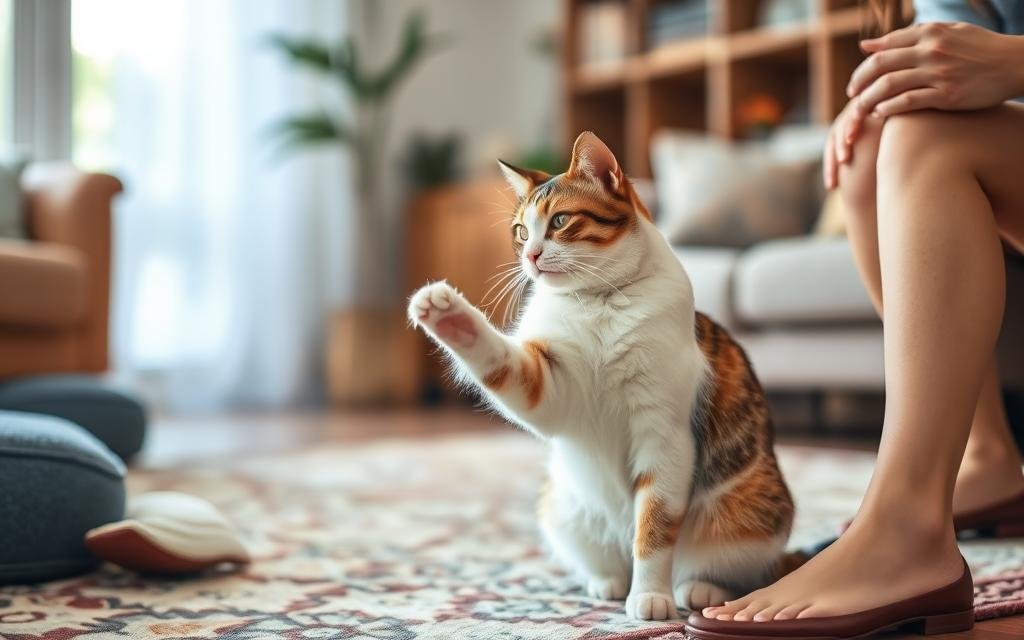Did you know over 70% of cat owners face behavioral challenges? This shows how important it is to know how to train cats. Problems like scratching furniture and litter box issues come from natural behaviors. With the right approach, we can change these behaviors.
In this guide, I’ll share tips that have helped me and my cat. We’ll talk about why training is key and how to make it fun for both of us.
Key Takeaways
- Understanding common cat behaviors is essential for effective training.
- Positive reinforcement helps encourage desired behaviors.
- Creating a calm training environment can reduce stress for my cat.
- Recognizing when to seek professional help is important for complex issues.
- Tracking progress in training strengthens our bond over time.
Understanding My Cat’s Behavior
Getting to know my cat’s ways is key to training them well. The more I understand about common cat behaviors, the better I meet their needs. Cats show many behaviors, each with its own meaning and context.
Common Cat Behaviors I Encounter
Some common behaviors I see include:
- Clawing furniture to mark territory
- Loud meowing when demanding attention
- Aggression during play or feeling threatened
- Urinary marking in response to stress or changes in the home
These behaviors often point to deeper issues that need attention. By recognizing their importance, I can create effective training plans.
The Role of Instinct in Feline Behavior
Knowing about cat instincts helps me understand their behavior. Cats are natural hunters, which shows in their play. For instance, my cat may chase toys like it’s hunting.
This knowledge helps me find the right ways to let them express their instincts.
| Behavior | Possible Cause | Response Strategy |
|---|---|---|
| Clawing | Territory marking | Provide scratching posts |
| Loud Meowing | Seeking attention | Schedule interactive playtime |
| Aggression | Fear or overstimulation | Create a calm environment |
| Urinary Marking | Stress or medical issues | Consult a vet for assessment |
By understanding cat instincts and behaviors, I can make better training plans. This approach helps me connect better with my cat.
Why Training My Cat Matters
Training my cat is key to our relationship. It’s not just about fixing bad habits. It helps us grow closer. By using fun training methods, we build trust and talk better.
Our training sessions become happy times for both of us. This makes our bond stronger.
Strengthening Our Bond Through Training
Training helps us bond more. We share fun moments that make our connection deeper. Playing while learning new tricks makes our time together special.
This makes us work together better. Our interactions become more meaningful and fun.
Encouraging Positive Behaviors with Training
Training my cat helps him behave better at home. Using positive rewards teaches him good habits. This makes him feel good about himself and less likely to misbehave.
Every step we take together makes our relationship better. It helps him follow his natural instincts in ways I approve of.
The Basics of Cat Training
Learning the basics of cat training is key to a great bond with my cat. Setting clear goals is the first step. I aim for achievable milestones to keep training fun for both of us.
Setting Realistic Goals for My Cat
I set small, reachable targets in our training. This approach prevents frustration and keeps us both motivated. Each goal is a step forward, helping my cat learn new things with excitement.
Tools I Use for Effective Training
Choosing the right tools is essential for success. I use clickers to give clear cues. Treats reward good behavior and motivate my cat. Playful toys keep sessions engaging and fun.
Keeping each session short, around five minutes, helps my cat stay focused. This mix of tools and techniques makes training enjoyable and effective.
Positive Reinforcement Techniques
Using positive reinforcement has really helped with my cat training. It makes my cat want to do good things because they get rewarded. It’s important to make sure they know what they did right.
This method not only makes my cat do things again but also makes us trust each other more.
Rewarding Good Behavior
When my cat does something good, I give them a reward right away. This helps them understand what they did right. Positive reinforcement works well if you do it consistently.
A simple “good job” can mean a lot to them.
Using Treats to Motivate My Cat
Using treats is a great way to get my cat to do what I want. I use small pieces of cat treats or even fish. This way, they get a tasty reward without eating too much.
I also use a clicker with treats. The clicker tells them exactly when they did something right. This makes learning easier for them.
| Type of Reward | Ideal Uses | Examples |
|---|---|---|
| Commercial Treats | Basic training commands | Small kibble or commercial cat treats |
| Fish | Training for more advanced tricks | Cooked salmon or tuna bits |
| Praise | Reinforcing good behavior | “Good job!” or gentle petting |
Using these positive methods makes training fun and effective. It helps my cat learn and stay happy and well-behaved.
Addressing Common Behavioral Issues
Dealing with cat issues like scratching, litter box habits, and aggression is key for a peaceful home. Each problem needs its own solution to keep my cat safe and happy.
Tackling Scratching with Training
To stop cat scratching furniture, I give my cat scratching posts to use. I put these posts in spots where my cat likes to scratch. They must be tall and strong. This way, my cat learns to scratch where it’s okay to do so.
Solutions for Litter Box Problems
Training my cat to use the litter box is a big task. The litter box’s location and how clean it is matter a lot. I place the box in a quiet spot and clean it often. I also try different litters to see what my cat likes best.
Managing Aggression in My Cat
Managing cat aggression starts with watching for what makes my cat upset. Knowing what triggers their anger helps me use special techniques to calm them down. I work to keep the environment calm, which helps my cat feel better overall.
Creating a Training Routine
Having a regular cat training routine is key for my cat’s learning. The best time to train is after play, when my cat is most focused. This makes our training sessions both fun and effective.
Time of Day: When I Train My Cat
Training after play keeps my cat active and mentally sharp. I try to train at this best time to make each session count. A routine also helps my cat know what to expect, making them less anxious and more positive.
Keeping Training Sessions Short and Fun
Short, fun training sessions of about five minutes keep my cat interested. Using toys and different activities makes learning enjoyable. This approach encourages my cat to cooperate and learn eagerly.
Positive rewards for good behavior strengthen our bond. Immediate rewards help my cat understand what actions are good. For more tips on training your cat, check out this resource.
Fun Tricks to Teach My Cat
Teaching fun tricks to my cat brings joy and strengthens our bond. I started with basic commands and then moved to more exciting challenges. Each step keeps my cat’s mind active and happy.
Teaching Basic Commands
Starting with commands like “sit” and “high-five” is a great first step. Clicker training works well for me. The click sound tells my cat they did something right, earning a reward.
As my cat gets better at these commands, our training sessions become fun bonding times.
Fun Far-Out Tricks to Try
Once my cat knows the basics, I introduce more complex tricks. “Jump through a hoop” is a fun choice that adds creativity and excitement. It’s important to choose tricks that fit my cat’s personality and comfort level.
This way, we both enjoy the show, and my cat gets a mentally stimulating activity.
Reducing Stress During Training
Effective training for cats needs a stress-free approach. I create a calm space for training, which helps both me and my cat. This calm setting lets my cat focus and learn better.
Creating a Calm Environment for My Cat
I pick a quiet spot in my home for training. This spot has less noise. I also avoid loud noises and sudden movements to keep my cat calm.
This peaceful setting makes training a positive experience. It turns training into a fun bonding time.
Knowing When to Take Breaks
It’s important to know when to stop training. If my cat seems bored or restless, I pause. This break helps my cat relax and reduces stress.
After a break, my cat is more focused. This makes our training sessions more rewarding for both of us.
For more on managing cat stress, I found an interesting article. It talks about stressors and their effects. You can read it here. It has helped me make my training sessions better and improve my cat’s happiness.
When to Seek Professional Help
At times, my cat may face challenges that require cat behavior professional help. It can be hard to know when to ask for help. Recognizing certain signs to seek trainer can make things easier. This ensures my furry friend gets the support they need for a happier, healthier life.
Signs My Cat May Need Expert Guidance
If my cat shows persistent aggression, extreme anxiety, or trouble with litter box habits, it’s time to seek help. Other signs include excessive scratching, biting, or avoiding play and interaction. It’s important to address these issues early for my cat’s well-being.
Finding the Right Trainer for My Needs
When looking for a cat trainer, thorough research is key. I look for trainers who use positive reinforcement and have the right credentials. Reading reviews and testimonials from other cat owners is also important.
Keeping an open line of communication with a trainer is vital. They can then tailor their approach to fit my cat’s unique needs. For more tips on choosing a cat trainer, I check out Smart Pet Tips.
Celebrating Progress with My Cat
Throughout our training journey, celebrating progress is key to staying motivated. Keeping a training journal helps me track our progress. I write down every new command or behavior improvement my cat makes.
Recognizing and rewarding my cat’s achievements boosts both of us. I love celebrating even the smallest victories. This shows my cat that hard work is rewarded, encouraging them to keep learning.
These moments of celebration strengthen our bond and create a positive training environment. By tracking our progress and celebrating, I show my cat that every step is important. This journey is about growing together and enjoying each other’s company.





















